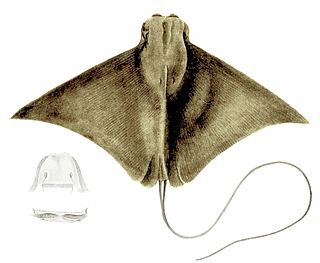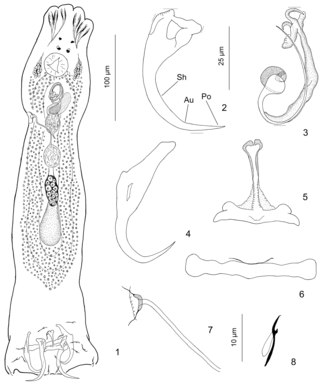
Stingrays are a group of sea rays, a type of cartilaginous fish. They are classified in the suborder Myliobatoidei of the order Myliobatiformes and consist of eight families: Hexatrygonidae, Plesiobatidae, Urolophidae (stingarees), Urotrygonidae, Dasyatidae, Potamotrygonidae, Gymnuridae and Myliobatidae . There are about 220 known stingray species organized into 29 genera.

The eagle rays are a group of cartilaginous fishes in the family Myliobatidae, consisting mostly of large species living in the open ocean rather than on the sea bottom.

The cownose ray is a species of Batoidea found throughout a large part of the western Atlantic and Caribbean, from New England to southern Brazil. These rays also belong to the order Myliobatiformes, a group that is shared by bat rays, manta rays, and eagle rays.

Franz Steindachner was an Austrian zoologist, ichthyologist, and herpetologist. He published over 200 papers on fishes and over 50 papers on reptiles and amphibians. Steindachner described hundreds of new species of fish and dozens of new amphibians and reptiles. At least seven species of reptile have been named after him.

The brownspotted grouper, also known as the brown spotted reef cod, brown-spotted rockcod, coral grouper or honeycomb cod, is a species of marine ray-finned fish, a grouper from the subfamily Epinephelinae which is part of the family Serranidae, which also includes the anthias and sea basses. It has an Indo-Pacific distribution but in the northern Indian Ocean this distribution is discontinuous. It forms part of a species complex with two closely related species in the genus Epinephelus.

The blacktip grouper, also known as the redbanded grouper, blacktipped cod, black-tipped rockcod, footballer cod, red-barred cod, red-barred rockcod, scarlet rock-cod or weathered rock-cod, is a species of marine ray-finned fish, a grouper from the subfamily Epinephelinae which is part of the family Serranidae, which also includes the anthias and sea basses. It is found in the tropical Indo-Pacific region. It is the type species of the genus Epinephelus.

The Brazilian cownose ray, also commonly called the Ticon cownose ray, is a species of fish in the family Rhinopteridae. Its range extends along the coast from the southern tip of Brazil to western Florida. Its natural habitats are shallow seas, estuarine waters, and intertidal flats.

Rhinoptera is a genus of ray commonly known as the cownose rays. This genus is the only member of the family Rhinopteridae.

The flapnose ray or Javanese cownose ray is a species of fish in the family Rhinopteridae. It is found in the Indo-Pacific off China, India, Indonesia, Iran, Japan, Madagascar, Malaysia, Mozambique, Pakistan, the Philippines, Seychelles, Somalia, South Africa, Sri Lanka, Taiwan, Tanzania, Thailand, Vietnam and possibly Australia. Its natural habitats are open seas, shallow seas, subtidal aquatic beds, coral reefs, estuarine waters, and coastal saline lagoons.

The golden cownose ray or Pacific cownose ray is a species of ray. It is found in the East Pacific along the coast of Colombia, Costa Rica, Ecuador, El Salvador, Guatemala, Honduras, Mexico, Nicaragua, Panama, and Peru. Its natural habitats are open seas, shallow seas, subtidal aquatic beds, estuarine waters, intertidal marshes, and coastal saline lagoons. They are often in schools, and sometimes associated with the spotted eagle ray.
The rough cownose ray is a species of eagle ray in the genus Rhinoptera.

The whitespotted grouper, also known as the rankin cod, ocellated rockcod, small-spotted cod, white-spotted reef-cod or whitespotted rockcod, is a species of marine ray-finned fish, a grouper from the subfamily Epinephelinae which is part of the family Serranidae, which also includes the anthias and sea basses. It has an Indo-Pacific distribution. It is closely related to two other species of white spotted groupers in the genus Epinephelus.

Aristocleidus is a genus of monogeneans erected by Justus F. Mueller in 1936. The genus has been revised by Delane C. Kritsky and Edgar F. Mendoza–Franco in 2008. The amended generic diagnosis is: species with gonads overlapping, ventral anchors with deeply incised base forming deep and superficial roots, a coiled tube of the male copulatory organ in a clockwise orientation, and haptoral hooks with upright acute thumb, slender shank comprising one subunit and FH loop.

Rhinoptera marginata, the Lusitanian cownose ray, is a species of ray found along the western coast of Africa and Mediterranean Sea. It is apparently rare in the Mediterranean Sea, but is common in shallow waters off the western Africa.
Euzetia lamothei is a flatworm which parasitizes the gills of the cownose ray. It is named after Dr. Marcos Rafael Lamothe Argumedo, a professor at Universidad Nacional Autónoma de México who has done research on Monogeneans. The species averages 405 micrometers long by 178 micrometers wide. It can be distinguished from its closest relative, Euzetia occultum, based on size and the morphology of the reproductive organs.
Euzetia occultum is a species of flatworm which parasitizes the gills of the Australian cownose ray and is the type species for its genus. It can be distinguished from Euzetia lamothei based on its overall size and reproductive morphology.
Caballerorhynchus is a monotypic genus of acanthocephalans containing a single species, Caballerorhynchus lamothei, that infests animals.
Burnhamia is an extinct genus of devil ray from the Paleogene period. Due to superficial similarities, some species were originally mistaken for Cownose rays and placed in the genus Rhinoptera. It is known exclusively from dental batteries, mostly isolated teeth. There are several species attributed to this genus but their relation to each other is still unresolved. Some have proposed the type species B. daviesi arises in the late Paleocene and persists until the middle Eocene giving rise to the similar genus Eoplinthicus with an earlier offshoot leading to smaller and less ornamented species in the lower Eocene, namely B. fetahi. B. fetahi is known from Morocco and North America. B. daviesi was described from the London Clay Formation, but is well known from Eocene deposits throughout Asia, Europe, North Africa, and North America. However, teeth from the Claiborne Group of Alabama show teeth identical to B. daviesi coexisting with Eoplinthicus in the Bartonian. A Ypresian species, B. nessovi, known from a singular site in Kazakhstan was tentatively ascribed to the genus, though more material may show it warrant its own. B. crimensis is known from the Bartonian and Priabonian of Crimea.

Rhinoptera neglecta, the Australian cownose ray, is a species of the Rhinopteridae family. It is found in the Western Pacific Ocean from Queensland to New South Wales in Australia. The species is 86 centimeters long.












